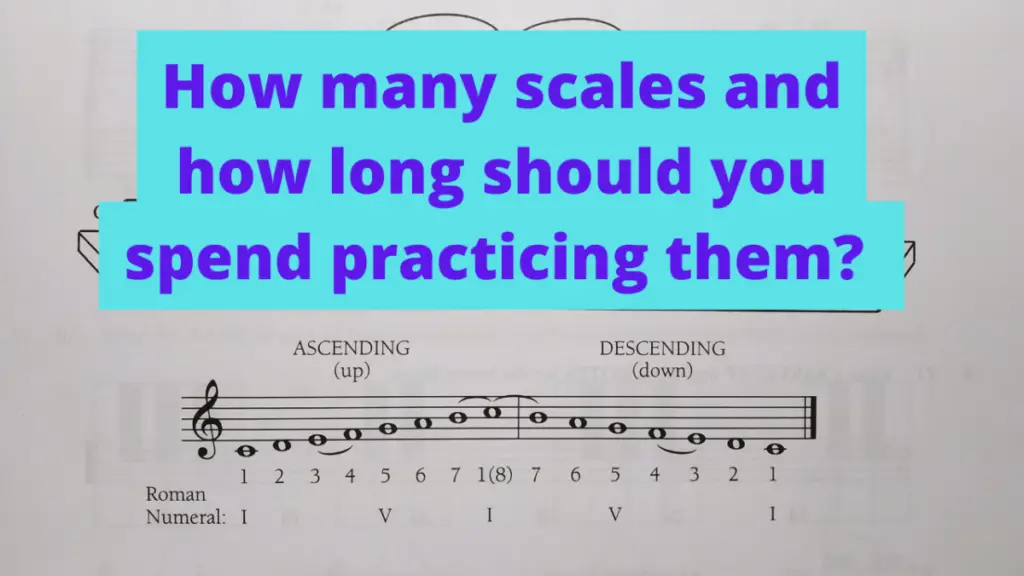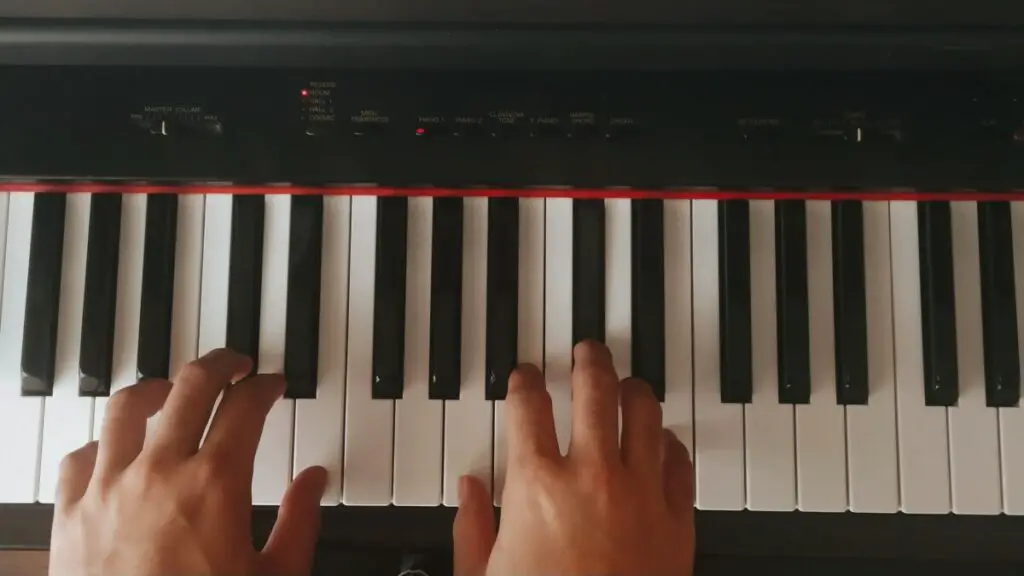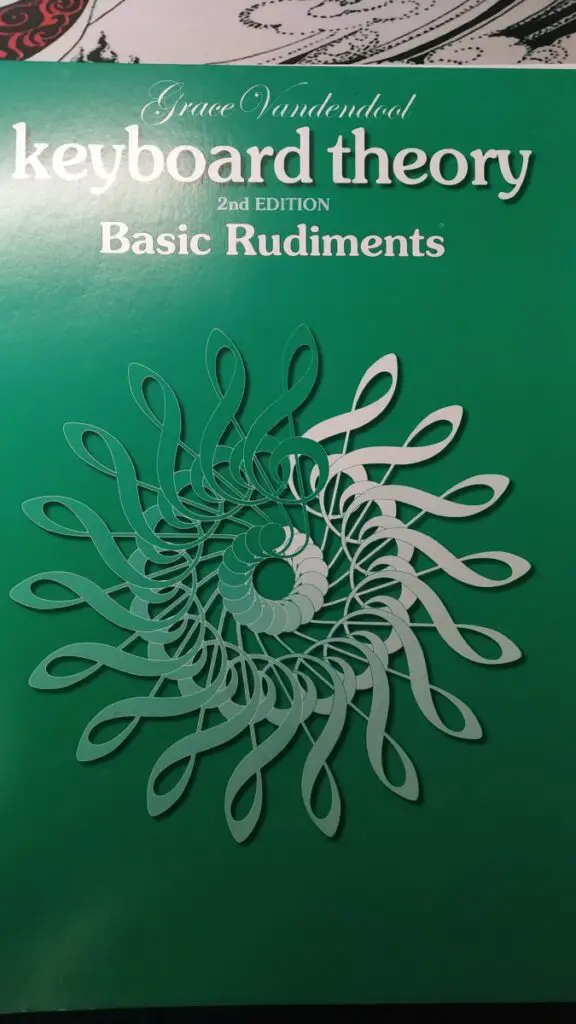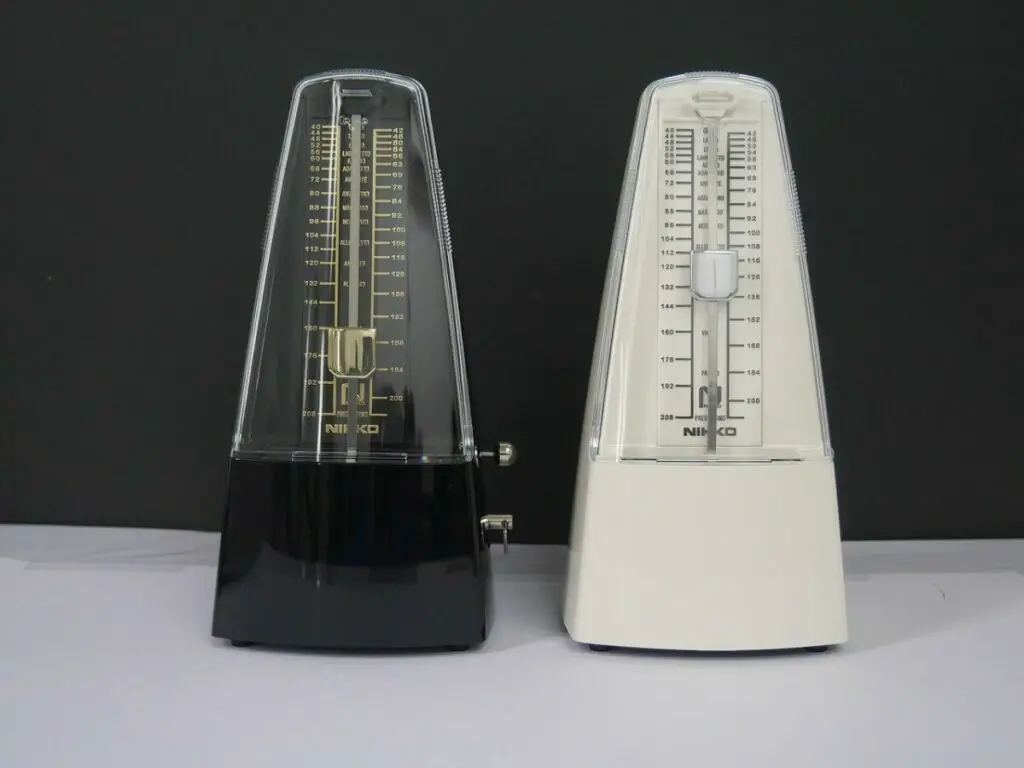This post contains affiliate links.

Practicing scales can significantly improve your piano playing. However, how do you practice scales efficiently?
How many scales should you practice, and what’s the least amount of time you should spend practicing them? Because let’s be honest, practicing scales isn’t the most fun exercise, and we all would rather spend time playing piano pieces.
In this article, I’ll answer these questions, as well as talk about how long learning one piano scale takes, and how fast should you be able to play scales. Finally, I’ll give some tips to learn piano scales effectively.
How many piano scales should you practice every day?
As a general rule, you should practice at least 3 to 4 piano scales you already knew every day. Rotates to different scales every day if you know many scales so you won’t forget the scales’ fingerings. You should also spend some time learning a new scale to eventually know all piano scales.
Of course, you can choose to practice more or fewer scales. However, I find 4 scales per day to be the best amount since there are 48 scales in total (Major, natural minor, harmonic minor, melodic minor) and I need to practice them all to not forget their fingerings, while at the same time, I want to spend the least amount of time practicing scales so I can spend more time playing piano pieces.
How long should you spend practicing piano scales every day?
You need to spend at least 10 minutes every day practicing piano scales that you already knew to not forget their fingerings, along with learning one new scale. You can spend more time practicing if you want to learn and master scales faster.
However, you shouldn’t spend any less than 10 minutes practicing scales as you’d need 5 minutes to go through 3 to 4 scales you knew and another 5 minutes practicing a new scale, although I find I need more than 5 minutes when learning a new scale.
It’s also important that you practice scales every day. It’s very easy to mix up fingerings of different piano scales out there as you learn more and more scales, so you should practice every day so the fingerings are forever stuck in your head.

Practicing scales every day also helps develop your finger strength and dexterity as you have to play scales with awkward fingerings and play all the notes evenly. Many pieces have scale passages in them so if you already had experience with scales beforehand, you’ll have an easier time learning those scale passages.
It’s because of these benefits that even advanced or concert pianists still spend time going through scales every day, although they don’t practice individual scales like we do since those scales and the fingerings are second nature to these pianists.
Instead, these pianists practice scales by going through Etudes, which are short compositions written specifically to practice scales or train other piano skills.
There are many more benefits to practicing scales and I talked about them in the article Can You Learn Piano Without Knowing Scales? (and why you should learn scales anyway)
With that said, if you’ve practiced scales, you would know that it’s a boring activity. Going up and down the same scales, all the time gets dull very fast. However, you can’t ignore all the benefits of practicing scales. Thus, this is where having a routine will help make practicing scales more bearable:
Spend the first 10 minutes of every piano practice session practicing scales, treat it as a warm-up exercise to prepare your fingers and make them less stiff before you play any piano piece. After a while, you won’t find practicing scales boring anymore. In fact, you’ll instead get that “missing something” feeling if you don’t practice scales.
How long does it take to learn piano scales?
To be able to play one new scale comfortably in one octave with both hands, you’d need to spend at least 30 minutes. Of course, some people will only need to spend a little time learning one scale while others may need more time learning that same scale. It depends on the person’s skills and abilities.
However, once you can play the scale with both hands in one octave, I recommend you spend the rest of the week practicing that scale, without picking up another new scale. This is because it’s easy to mix up the fingerings of different scales, so having that extra time engraining the fingerings of one scale in your brain helps.
That extra time will also allow you to learn to gradually play the scale at a faster tempo with both hands or play the scale in contrary motion – where your right hand goes up the scale while your left hand goes down the scale, along with other exercises to further master that scale.
With a total of 48 scales (major, natural minor, harmonic minor, melodic minor), it’ll take at least 24 weeks to learn them all.
The reason why it doesn’t take 48 weeks if you learn one new scale per week is that once you know a natural minor scale, the harmonic and melodic are easy to do since those are just the natural minor scale with one or two notes shifted a half-step up. Thus, when learning scales of a minor key signature, you would usually know the natural, harmonic and melodic minor scales at the same time.
Aside from harmonic and melodic minor scales taking less time to learn, some scales are trickier than others and take more time to learn, while some scales have the same fingerings so if you know the fingerings of one, the other scales will come naturally to you.
I wrote in detail and give examples of factors that can affect how quickly you learn scales in How Long Does it Take to Learn Piano Scales?
How fast should you be able to play piano scales?
Work towards being able to play every piano scale at 120 beats per minute, playing four notes per beat. This is one of the requirements for the RCM level 10 exam, so if you can comfortably play scales at this tempo, you are in good shape and can play scales in most piano pieces.

For those that don’t know, the RCM Certificate Program (Royal Conservatory of Music) is a well-known and rigorous program in North America. It’s split into 10 levels (1-10) with level 10 being the hardest.
RCM level 10 is so hard that for some students, it would take at least 2 years of practice to pass the exam. If you pass level 10, you’ll be considered a well-rounded pianist. Thus, the tempo required by the RCM level 10 exam is the ultimate goal for playing scales.
Of course, you can choose to practice to be able to play scales at an even faster tempo since some pieces demand a crazy fast tempo for scales. However, being able to play scales at 120 beats per minute, playing 4 notes per beat is more than sufficient for most scales you’ll encounter in piano pieces.
With that said, working towards playing scales at that fast tempo is no easy task and can take weeks or months to be able to play without mistakes. Below, I give some tips that can help make the learning process a bit easier.
Tips for learning piano scales
Learning key signatures
The key signature determines what sharps or flats are in a piano piece or a scale. Instead of mimicking the fingerings from youtube videos when practicing scales, being able to recognize the key signature and identify the sharps and flats in a scale is an easier and faster way of memorizing scales.
For example, when talking about the D Major scale, you should know immediately that the scale has F# and C# without relying on muscle memory by playing the scale on the piano and identifying the sharps that way.
You can learn about key signatures and other concepts to have a better understanding of the components that make up a piano piece by going through theory books.
For example, I went through this theory book with my teacher and learn many concepts like major and minor scales, semitones vs whole tones, major and minor triads, etc. The thing I like about this book is that the concepts are organized logically where you learn a new unit using the knowledge you have from the previous units.
You can buy Keyboard Theory by Grace Vanderdool here on Amazon (affiliate link).

Also, by practicing scales regularly, you’ll slowly memorize the key signature of each scale and be able to name the sharps of flats present.
Use a metronome
Using a metronome when practicing scales can help you play all the notes evenly. This is especially helpful when you’re playing the scale at a fast tempo and some notes seem to blend together because your fingers are moving too fast.
When choosing a metronome, there are 3 options available: mechanical metronomes, digital metronomes that resemble stopwatches, or metronome apps on your phone

So which one is right for you? You should avoid mechanical metronomes although they look cool because if you put them on an uneven surface, the beats will be off and can negatively affect your piano playing. Even though the top of your piano may look even to the human eyes, it may be uneven.
Between digital metronomes or metronome apps, which one you should choose depends on your taste: do you prefer having a physical metronome? For me, the metronome app is good enough and has all the features I need. Moreover, it’s free.
Practice at a slower tempo
There’s nothing wrong with practicing scales at a slow tempo first then gradually building up to a fast tempo. In fact, practicing at a slower tempo is more beneficial because it ensures you’re playing the scale with proper fingerings.
If you’re practicing scales at a fast tempo right of the bat, you may risk playing sloppily as you’re not familiar with the scale. It also takes less time and effort to gradually build up speed when practicing scales compared to practicing scales at only a fast tempo.
Remember that if you can play a scale slowly, you can play that scale quickly.
Practice two hands separately first
You may be tempted to practice the scales with both hands at the same time right off the bat. However, this is not efficient as playing a scale with both hands is significantly harder than with only one hand. Thus, it’s better to practice the scale in each hand separately first before combining them.
Remember that there’s no rush in learning scales. It’s better to slow down and break the scale down into smaller pieces (practice two hands separately) to get the fundamentals right first, before increasing the difficulty gradually.
Try different exercises to further master the scale
Playing a scale in two octaves in a parallel motion where both hands go up or go down the scale isn’t the only way to practice the scale. There are other exercises that can help you be more fluent in a particular scale. Also, these exercises are fun and can spice up your boring scale practicing session.
One of these exercises is playing the scale in contrary motion, where your right hand goes up the scale while your left hand goes down the scale, then vice versa. For many scales, if you can play them in parallel motion, contrary motion won’t be much harder since the fingerings for both hands are the same
Another exercise is playing the scale off-beat, where you play the notes in between the beats on a metronome. This exercise is harder than it sounds and I recommend you set the metronome to a slow tempo so you can clearly notice the gaps between beats.
You can combine many of these exercises together, so for example, you can try playing the scale off-beat and in contrary motion.
Optimal order for learning scales
This goes back to learning and understanding music theory. There’s this concept called “the circle of fifths” that organize the different pitches and many piano teachers have their students learn scales using the circle of fifths.
Or you can learn any random major scale and its natural minor scale since they both have the same sharps or flats. Once you learned the natural minor scale, proceed with learning the harmonic and melodic minor scales since these 2 scales are just the natural minor scale with some notes shifted a semitone up.

